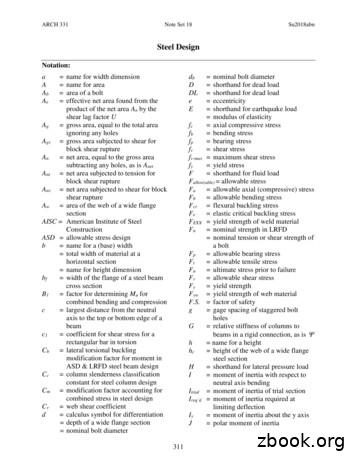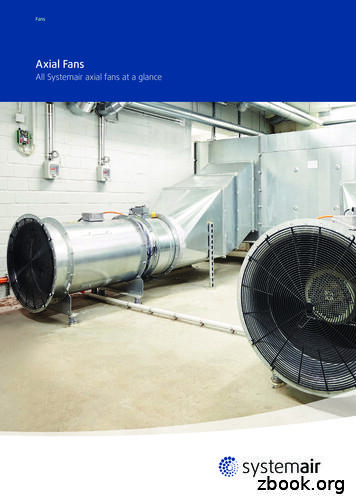Increased LRFD Axial Resistance Factors For Piling Using Static Load .
MICHGAN BRIDGE CONFERENCE Increased LRFD Axial Resistance Factors for Piling Using Static Load Test and PDA Testing Christopher Naida, P.E., SME Chris D. Johnecheck, P.E., Michigan Department of Transportation March 17, 2015
OVERVIEW How Load Resistance Factor Design (LRFD) is addressed in driven pile design Two aspects: construction and design (estimating pile lengths) MDOT implementation of Dynamic Testing (PDA) and Static Load Tests Case studies
LRFD Design for Pile Driving General LRFD Equation Σ η*γ*Q φ*Rn η Load Modifier (redundancy, operational importance) γ Load Factor Q Service Load or Force φ Resistance Factor Rn Nominal Pile Bearing Resistance (Ultimate) Factored Geotechnical Resistance (RR): RR φ*Rn φstatic*Rs φstatic*Rp φdyn*Rn φstatic resistance factor for static analysis method used to estimate pile lengths (Table 10.5.5.2.3-1) φdyn resistance factor for dynamic method used to verify nominal pile bearing resistance (Table 10.5.5.2.3-1) Rs & Rp pile side and tip resistance used to estimate pile lengths Rn is used as the basis for determining Rndr during pile driving
LRFD Design for Pile Driving (continued) RR φdyn*Rndr (assumes no scour or downdrag on pile) φdyn value is based on type of quality control used in construction Quality Control During Construction Dynamic Formula (modified gates formula) φdyn 0.5 Dynamic Pile Testing (PDA) φdyn 0.65* Static Load Test φdyn 0.75 – 0.8* (may decrease based on site variability) * Requires dynamic testing with signal matching, and best estimates are made from a restrike
Saximeter
PDA Gauges
M-85 Load Test
TYPICAL NOMINAL PILE DRIVING RESISTANCE (Rndr) Steel H Piles Pile HP 10X42 HP 10X57 HP 12X53 HP 12X74 HP 12X84 HP 14X73 HP 14X89 (Rndr) 275 kips 350 kips 350 kips 500 kips 600 kips 500 kips 600 kips
TYPICAL NOMINAL PILE DRIVING RESISTANCE (Rndr) continued Cast-in-Place Concrete Piles Pile Size (Rndr) Metal Shell 12" O.D. w/0.312" Walls Metal Shell 14" O.D. w/0.312" Walls Metal Shell 16" O.D. w/0.375" Walls 250 kips 350 kips 500 kips Timber Pile Timber Pile (Rndr) 150 kips
Factored Nominal Pile Bearing Resistance Example Assume geotechnical engineer uses Rndr 350 kips Dynamic Formula (modified gates formula) RR φdyn*Rndr RR 0.5 (350 kips) 175 kips Dynamic Pile Testing (PDA) RR 0.65 (350 kips) 227 kips Static Load Test RR 0.8 (350 kips) 280 kips Designer can use higher factored resistance when specifying a more reliable form of Quality Control
Perform Economic Analysis General rules for Resistance Factor (φdyn) (detailed analysis shall be performed) * Project Driven Pile Cost Pile Certification Method Resistance Factor (φdyn) 300,000 FHWA-Modified Gates Formula 0.50 300,000 Dynamic Testing/Signal Matching (PDA Testing) 0.65 * 500,000 Static Load Test 0.55 ‒ 0.90 0.80 This resistance factor applies to the Beginning of Redrive (BOR) case.
Estimating Pile Lengths for Contract Documents AASHTO Bridge Design Manual states (C10.7.3.3): The estimated pile length necessary to provide the required nominal resistance is determined using static analysis, local pile driving experience, knowledge of the site subsurface conditions, and/or results from a static pile load test program. In lieu of local pile driving experience, consider the following equation using static analysis: φdyn*Rn φstatic*Rnstat (C10.7.3.3-1) Rnstat predicted nominal resistance from the static analysis used to estimate pile lengths
AASHTO Static Resistance Factors-φstatic
Estimating Pile Length Example φdyn*Rn φstatic*Rnstat .equation estimates lengths reasonable when using the dynamic formula (modified gates) and associated φdyn 0.5 Example: Assume Rndr 350 kips, a sand profile, and using the modified gates formula for quality control Using dynamic formula: 0.5 * 350 kips 0.45 * Rnstat .estimate pile length based on Rnstat 390 kips Caution: When using extreme limits of static & dynamic analysis: 0.8 * 350 kips 0.45 * Rnstat . Rnstat 620 kip
Contract Documentation of Design Note the Rndr on the design plans. Note the dynamic resistance factor utilized in the design analysis on the design plans. If loss of resistance due to scour or downdrag are expected, quantify these losses on the design plans. Include dynamic testing or static load test SP in contract documents if specified on the project.
Increased LRFD Axial Resistance Factors for Piling Using Static Load Test and PDA Testing Case Studies
Benton Harbor Project Overview New 6-story building supported on H-piles (HP10x42) Designed for lengths of 150 feet to penetrate extremely dense sands Driven lengths of 150 to 190 feet Construction manager getting claims from piling contractor due to longer piles Photo Courtesy of Yahoo Maps
Benton Harbor – Soil Conditions Loose sands and organics (e.g., peat) over extremely dense sands Photos Courtesy of SME
Benton Harbor Results Photo Courtesy of SME Drove P719 from 140 to 153 feet o Axial pile capacity was below the requirement Re-strike on P716 previously driven (3 days from initial drive) o Increased blow counts (resistance) met design o Reduced blow counts with driving (i.e., 10, 7, 6, 4, 2 bpi) o Localized loss of support from fine silty sands
Benton Harbor Results Pile and soil observations o Cycled loading from pile driving Increased pore water pressures, reduced skin friction and soil plug formation at pile tip Led to softening and accumulation of deformation (e.g., decreasing blow counts and capacity) o Setup and Re-strike (3 days later) Time allowed sands to reduce pore water pressure Increased effective stress and pile capacity
Benton Harbor – “Easy” Initial Driving Photos Courtesy of SME
Benton Harbor – “Hard” Driving during Re-strike Photos Courtesy of SME
Thompson Township Project Overview New bridge supported on pipe-piles o 12.75 inch dia. with a 0.375 inch thick wall o 0.75 inch steel plated bottom Piles were designed for lengths of 35 feet to penetrate into dense sands Photo Courtesy of Yahoo Maps
Thompson Township – Soil Conditions Loose sands and organics over dense sands Decreasing strength to medium dense sands over limestone Artesian water flow with positive pressure flow of 15 gal/min out of borehole Water flow occurred between elevations 567 to 544 feet Photo Courtesy of MDOT
Thompson Township – Pile Installation Criteria Required nominal capacity of 115 kips Initial drive of pile to minimum tip elevation of 588 feet in dense sands o Measure capacity and stop if met o If needed continue driving Continue driving pile to maximum tip elevation of 569 feet (above artesian water elevation of 567 feet) o Measure capacity and re-strike as needed o If required reduce capacity and add more piles Photo Courtesy of MDOT
Thompson Township – Results Abutment B piles achieved capacity in upper dense sands Abutment A piles achieved capacity in lower medium dense sands Photo Courtesy of SME
Questions?
pile lengths (Table 10.5.5.2.3-1) φ dyn resistance factor for dynamic method used to verify nominal pile bearing resistance (Table 10.5.5.2.3-1) R s & R p pile side and tip resistance used to estimate pile lengths R n is used as the basis for determining R ndr during pile driving
Recently, we were made aware of some technical revisions that need to be applied to the AASHTO LRFD Bridge Design Specifications, 6th Edition. Please replace the existing text with the corrected text to ensure that your edition is both accurate and current. AASHTO staff sincerely apologizes for any inconvenience.File Size: 2MBPage Count: 104Explore furtherAASHTO LRFD 2012 Bridge Design Specifications 6th Ed ( US .archive.orgAASHTO Issues Updated LRFD Bridge Design Guideaashtojournal.orgAASHTO Publishes New Manual for Bridge Element Inspection .aashtojournal.orgAASHTO LRFD Bridge Design Specifications. Eighth Edition .trid.trb.orgSteel Bridge Design Handbook American Institute of Steel .www.aisc.orgRecommended to you b
AASHTO LRFD Bridge Design Specifications, 4th Edition, with 2009 interims AASHTO LRFD Bridge Design Specifications, 5th Edition AASHTO LRFD Bridge Design Specifications, 5th Edition, with 2010 interims AASHTO LRFD Bridge Design Specifications, 6th Edition AASHTO LRFD Bridge Design
LRFD steel design P r required axial force P u factored column load calculated from load factors in LRFD steel design Q first moment area about a neutral axis generic axial load quantity for LRFD design r radius of gyration r y radius of gyration with respect to a y-axis R generic load quantity (force, shear, moment, etc.) for .
Fan installation with accessories 9 Technical description 10 Installation types 11 Axial fans AXC, AXCP, AXR 12 Axial fans AXCPV 18 Smoke extract axial fans AXC (B), AXR (B) 22 Smoke extract axial fans AXC (F), AXR (F) 24 Thermo axial fans AXCBF 26 Explosion proof axial fans AXC-EX, AXCBF-EX 30 Jet fans for Car Park Ventilation 36 Tunnel fans 37
AASHTO LRFD speci cations.1 1.25D 1.50DW 1.75(LL IM) R (2) The load and resistance factors in the 2014 edition of the American Association of State Highway and Transportation Ocials’ AASHTO LRFD Bridge De-sign Specifications were determined usi
AASHTO LRFD Bridge Design Specifications, 8th Edition (LRFD-8) May 2018 . Dear Customer: Recently, we were made aware of some technical revisions that need to be applied to the AASHTO LRFD Bridge Design Specifications, 8th Edition. Please scroll down to see the full erratum.File Size: 2MB
FHWA/NHI Bridge Design and Analysis Courses (www.nhi.fhwa.dot.gov) NHI Course 130081: LRFD for Bridge Superstructures NHI C 130082NHI Course 130082: LRFD f B id S b t t d ERSLRFD for Bridge Substructures and ERS NHI Course 130092: LRFR for Highway Bridges NHI Course 130093: LRFD Seismic Analysis and Design of Bridges NHI Course 130094: LRFD Seismic Analysis and Design of Tunnels,
foundations will lead to savings or to equivalent foundation costs compared with ASD methods. At the end, a roadmap for development of LRFD design guidance that consists of LRFD design specifications and delivery processes for bridge foundations is discussed. 17. KEY WORDS: LRFD, ASD, limit AASHTO, 18. DISTRIBUTION STATEMENT























